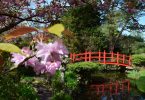When during one of the previous nights, busy working away at the desk of my tented suite at the Olare Mara Kempinski Safari Resort, I heard some lions making noises not too far from my tent, I tweeted:
Dr. Wolfgang H Thome @whthome
I wonder what these lions have to talk about at this hour, perhaps discussing menu choices? #TembeaKenya @MagicalKenya #OlareMaraKempinski
Little did I know what was to be in store for me the next day. The camp’s tent number 2 had apparently become a lion nursery with two little cubs tucked away under the platform. A lioness had actually given birth right there some days earlier, effectively shutting down the use of this and the neighboring tents to avoid any incident with mother Leo.
The cubs, left in relative safety and shaded from the blistering sun heat of the day, remained in their lair while their mother periodically went out to hunt for food. When the camp staff, by the way an amazing group of young people keen to please and anticipate one’s every wish and fancy, was reasonably certain that the lioness was some considerable distance away and would not return any time soon, a one minute window of opportunity opened up to quietly sneak close to the cubs and take but one picture, before equally quietly but much more hastily withdrawing back into a safe distance. Lionesses are known to be fiercely protective when they come to the defense of their litter and one does not want to stand between her and the cubs, ever.
It was suddenly clear to me that the previous night the mother must have “talked,” perhaps with another adult lion some distance away, about what they would have for breakfast, and then on soft silent paws sneaked out into the darkness to hunt by stealth, tanking up the strength needed to in turn feed her two cubs who by their size were, of course, still at the suckling age.
Nature’s miracles of this sort, and I cannot find a more befitting word, happen far and few between, even for someone like myself who regularly ventures out into the bush to discover new properties, rediscover paths trodden long ago and stay in touch with what Kenya’s parks, like the Masai Mara Game Reserve, continue to have in store for visitors.
These are travelers who especially in times like now defy anti-travel advisories and negative publicity and come to Kenya to have that safari of a lifetime they have always dreamed about, undeterred by sensationalist media reports which portray the country as unsafe, much of which, of course, is complete hogwash for those in the know.
I stayed at the very posh Olare Mara Kempinski, a 12 suites under canvas property recently voted as among the 10 best luxury properties in the world, and whatever one thinks of such surveys, the Olare Mara certainly stands a head taller than some of its close competitors I have stayed within the past.
The game drives began straight from the Ol Kiombo airstrip where Safarilink had, as usual, delivered me safely and on time. Plenty of zebras and wildebeest, giraffes, Thomson gazelles, warthogs, hyenas, a few buffalo, a lone dik and, of course, Grant gazelles and Topis lined the track to the camp which the vehicle reached within an hour, quite a few stops, of course, included en route to take pictures.
When reaching the camp a traditional Masai welcome awaited me and my fellow travelers by a group of 5 morans, the word for the young Masai warriors, who were dressed in their traditional attire. While watching them the bags were taken off the 4×4, cold juices and scented towels proffered and myself and the other visitors who had arrived on the same flight, were escorted to the lounge of the lodge for that quintessential safety briefing – much needed it turned out when we learned of the presence of a lioness with cubs within the camp compound.
And as if to underscore the advice NOT to leave the doors to the tented suites open, some monkeys raced by, unable to grab anything edible due to the watchful eyes of our Masai escorts but for sure being opportunistic little thieves, given half a chance. Be assured that should the door to the tent remain open for any length of time, and unattended, they will swiftly sneak in, try to grab the contents of the fruit basket and otherwise pilfer the bags for shiny contents and then make away, looking a pretty bunch of longfingers as they swing up into the trees which surround the camp and go beyond reach with their bounty.
The tents are generously spread about the compound, some surely 50 or more meters apart from the next and those closer together still giving ample room for privacy and all are standing tall on elevated platforms from where, to varying degrees, the Ntiaktiak river can be seen and where at night the hippos can be heard as they snort, or else crunch as they wander about grazing between the tents. The tents’ furnishings, including sunbeds on the large verandah, were ticking all the right boxes and an armchair WITH footrest stood strategically placed to look out from either behind the glass doors or at least during the day, through the open doors, giving some cool shade when the outside temperatures rise into the mid thirty Celsius range and even higher.
The nights though are quite cool but the bedcover provides warmth, as do two hot water bottles, and more if needed, and, of course, one finds those 5 – at least by my count – Kempinski special pillows which are fluffy and let one sink into dream land without giving a stiff neck. That is for those who do sleep, and my readers, of course, know that I rarely do, ever busy to find and tell stories on a 24/7 basis. As a special gesture for guests who get surprised by the cool evening clime, the camp offers branded fleece jackets, on loan I should add, but they can be purchased at the camp’s little shop which has a range of branded items on sale, all genuine Masai handicrafts, their colorful red and black or blue blankets and, of course, those quintessential t-shirts one needs to prove at home that “been there, done that and got the t-shirt to prove it.”
But back to the main reason why visitors from around the world flock to the Masai Mara and its adjoining conservancies, the wilderness experience and the game. For one it is the annual migration of the wildebeest, from mid to late June to often way into November, at times shorter, of course, and a spectacle second to none, when the amassed thousands upon thousands of wildebeest and zebras begin to leap into the water of the Mara River, running the gauntlet of the waiting crocodiles and other predators and make their way across to the plains full of fresh grass – which after their visit looks like a giant lawnmower had swept over the undulating hills.
The conservancies, however, are full of game all year round and often have a higher concentration of the prized cats visitors come for, with less other tourists impacting on the silent enjoyment of the unfolding scenes. Conservancy fees go towards the upkeep and the protection of these pristine wilderness areas, which over the past 10 to 15 years were turned from run down grazing grounds into a regenerated bush, where game thrives and where species abound.
While not finding the elusive leopard this time, two are said to be frequenting the camp neighborhood on a regular basis, we were not disappointed to find two other cats, lions and cheetahs. The camp staff told the tale of three prides of lions making the Olare Conservancy their home, with previously some 56 males, females and adolescents and after the birth of the two under tent two, that number has gone up to 58. Cheetahs are much less in numbers, of course, but we nevertheless spotted a female with a young cub, taking a nap of sorts and once in a while raising their heads, seemingly unaware that we had just passed a lioness on the prowl less than half a kilometer away.
The conventional game drives tourists do inside the reserve are supplemented on the conservancies by night game drives, which bring visitors close up and personal with nocturnal animals. Game walks across the conservancy, escorted by supremely knowledgeable guides and an armed ranger, allow to walk between the grazing zebras, gazelles and wildebeest, a sight never forgotten and ultimately superior to just sitting in the car and driving by. Here Bernard Muiruri was our guide and while “only” holding a bronze rating at present from the Kenya Professional Safari Guide Association, he will very soon sit for his exams to make it to silver level, and I have no doubt he will pass with flying colors. Knowledgeable and able to eloquently explain game and bird sightings he is also skilled in bush craft, a major bonus for discerning clients who expect well near perfection from their camps and the staff – and they will not be disappointed when coming to the Olare Mara Kempinski, of course.
Balloon safaris can be arranged, now at a reported cost of some US$550 per person and on such days an early pick up is arranged to make it to the rendezvous point at sunrise when the balloons take off. Two game drives a day is the norm but night game drives are arranged on request at no extra cost I should add, as are walks, either in addition or in lieu of a conventional drive into the bush. During my two night and three day stay we came across just one other vehicle from another camp and only once crossed paths with other guests staying at our camp, a sign that one truly gets to see game and come close up to some of the more than 500 bird species without any maddening crowds and even more maddening shouts of “AWESOME” and the like, excitement, of course, notwithstanding for first time visitors when they approach their first ever lion pride or see the elusive leopard.
This close up experience of nature is unparalleled and simply cannot be replicated when inside the main reserve, where minibuses are the conveyance of choice while on the conservancies those vehicles are not permitted and only custom build 4x4s are used, with radio link to their base, with bird and game books readily available and with binoculars provided by the camp for those who would arrive without this quintessential item.
Olare Orok Kempinski, of course, got a pool, unobtrusively watched over by the Masai morans who patrol the compound nonstop to make sure no wild animals are straying close and if they do to usher guests, should it be necessary, back to the main lounge. They carry, besides their spear, sword and rungu, a Kiswahili word for a cane or baton, a two way radio, a sign that their “equipment” has also changed with time.
Elevated from the main building is a little library and a classic brass telescope which if not used during the day for game watching can be used at night to star gaze as the skies above the conservancy sparkle like never seen in or around the big cities.
Early morning tea is served in the tents at precisely the requested time while breakfast, lunch and dinner, add afternoon tea to that, are taken in the lounge or the restaurant, indoors at night and outdoors during the day. The camp, of course, takes pride to arrange bush breakfasts, bush lunches and bush dinners, sundowners too which bring guests to vantage points where they can see spectacular sunsets, the stuff great memories are made of, and in our case, made in Kenya.
The camp staff, led by Fairman Muhingi, performed admirably well during my 2 night and 3 day stay and individuals like Esther Maranga and her colleagues from the combined front office and guest relations team, the waiting staff in the dining room and the team in the kitchen, all the guides we came in contact with and right down to the Masai askaris, all were at their Sunday best at all times and this blended into one great impression of a group of people who absolutely love doing what they were doing.
Impress did, of course, also the food, which from breakfast over lunch to dinner showed the pedigree of Kempinski. With two choices of main course, the camp’s chef was more than happy to prepare something else on request and as seen with some Japanese visitors, mix them their meat choices by serving a portion of both the lamb chops and the fillet mignon, which going by their subsequent chatter then caused them some serious culinary delights as they tucked into the meal.
Visitors to the Nairobi based Villa Rosa Kempinski can take advantage of special packages to fly to the camp, and while road travel is an option, nothing beats the 45 minute flight on one of Safarilink’s Cessna C208Bs or C208EXs, their Twin Otter or Dash 8 aircraft. It saves those crucial hours one can spend watching game instead of driving on the long and at times not the best road from Nairobi via Narok.
In conclusion, in spite of the challenges Kenya faces at present, the country’s hospitality industry continues to deliver a first class product and continues to have what it takes to make that dream of a safari of a life time come true. From the very posh luxury end of the market to more affordable budget safaris is Kenya’s safari operator fraternity ready to receive guests at a moment’s notice and then take them to the country’s national parks, game reserves or onto the growing number of private conservancies, where those guests who defy the doom- and naysayers can be sure of a warm welcome and a great time. Karibuni Kenya – the country is open for business and ready to welcome you.






















